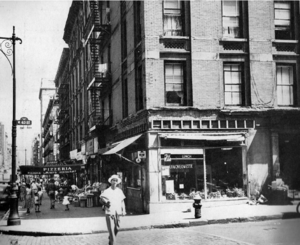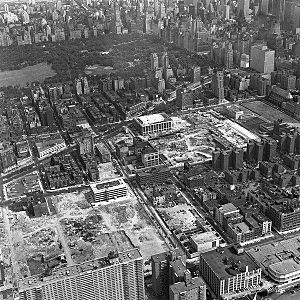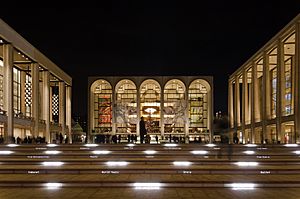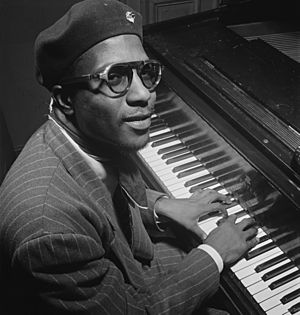San Juan Hill, Manhattan facts for kids
San Juan Hill was a lively neighborhood in what is now the Lincoln Square area of the Upper West Side in Manhattan, New York City. Many of its residents were African-American, Afro-Caribbean, and Puerto Rican families. Before World War I, it was one of the largest African-American communities in New York. San Juan Hill was located between 59th Street to the south, West End Avenue to the west, 65th Street to the north, and Amsterdam Avenue (part of Tenth Avenue) to the east. Today, this spot is home to Lincoln Center, a large 16.3-acre (6.6 ha) center for performing arts.
Contents
Why Was It Called San Juan Hill?
There are different ideas about how San Juan Hill got its name. Some people believe it was named after the Spanish–American War of 1898, which was fought in Cuba. Others say it was because African-American soldiers who fought in that war lived in the area. Another idea is that the name came from fights between African-American and Irish-American groups in the neighborhood.
A Look Back at San Juan Hill
African-American families started moving to San Juan Hill in the late 1800s. They came from Little Africa in Greenwich Village, where another African-American community used to be. Before Lincoln Center was built and San Juan Hill was changed, the neighborhood was a hub for jazz music and art.
Music and Culture
San Juan Hill had a famous jazz club called "Jungle Cafe." A jazz musician named Milton Mezz Mezzrow once said about a pianist from the area, "Here’s a boy from the Jungles who makes all the other piano players look sick!” Many believe the popular Charleston dance was created and first performed in this basement club. The musical history of the area continues today at Jazz at Lincoln Center. Historian Marcy S. Sacks noted that San Juan Hill had many basement clubs, from small dives to fancier places. There were also pool halls, saloons, and dance halls.
Community Life
San Juan Hill was home to many African-American churches. According to historian Marcy Sacks, these churches moved into the area around the 1880s and 1890s. Some of them included St. Mark's Methodist Episcopal and Mt. Olivet Baptist. St. Benedict the Moor Church was also nearby in Hell's Kitchen. The neighborhood also had many community groups and clubs, like the Grand United Order of Odd Fellows and the Colored Freemasons. This strong community also attracted veterans returning from the Spanish-American War of 1898, which might be why the area got its name.
Changes to the Neighborhood
San Juan Hill largely disappeared because of a big city project in the 20th century called "urban renewal." This project aimed to rebuild parts of the city. Thousands of families were forced to move, and many people today don't even know the neighborhood existed.
Moving Away
In the early 1900s, many African-Americans started to move uptown from San Juan Hill to Harlem. As the African-American population decreased, the Puerto Rican population grew. More Puerto Rican families moved there in the 1950s, especially after World War II. In the 1940s, the New York City Housing Authority called San Juan Hill "the worst slum district of New York City."
Building New Homes
In 1947, New York City decided to redevelop San Juan Hill. Parts of the neighborhood, from 61st to 64th Streets, were torn down. The Amsterdam Houses, a new housing complex, were finished in 1948. More than 1,100 families, mostly African-American and Puerto Rican, had to leave their homes for this project. In total, over 7,000 families and 800 businesses were displaced. The rent for new rooms after the project was too expensive for many original residents. However, a few old apartment buildings, like Phipps Houses on 63rd Street, still stand today. These buildings offered affordable housing, which was rare for people of color at that time.
Lincoln Center is Built
Declaring San Juan Hill a "slum" was the first step in a big city redevelopment plan. Robert Moses, a powerful developer, used a federal law called Title I of the 1949 Housing Act. This law allowed the government to take land for urban renewal projects. These projects often created housing for middle-class families but forced lower-income families to move. This is how space was made to build Lincoln Center. This change in San Juan Hill after World War II is seen as an early example of gentrification, where an area becomes more expensive and changes its character.
By the 1950s, most of the neighborhood was torn down, and Lincoln Center was built. In 1955, Robert Moses made a deal with the Met Opera to develop the area into a home for the arts. Other groups like Fordham University, the New York Philharmonic, and the Juilliard School of Music also moved their main offices and campuses there. Before construction began in 1959, over 17,000 people lived in the area.
San Juan Hill's Legacy
San Juan Hill is remembered as the birthplace of the Charleston dance and Bebop music. Today, Lincoln Center is home to famous groups like the New York City Opera, New York Philharmonic, New York City Ballet, and the Metropolitan Opera.
The 1926 musical Lulu Belle by David Belasco was partly set in this community. It was later made into a film in 1948.
The 1961 film West Side Story was filmed using parts of San Juan Hill after its buildings were condemned. Piles of rubble from recently torn-down buildings can be seen in many scenes. The 2021 film version of West Side Story also uses the neighborhood as its setting, adding the detail of Lincoln Center's construction as a key part of the story.
Famous People From San Juan Hill
- Thelonious Monk, a famous jazz pianist, grew up in San Juan Hill. He lived in the Phipps Houses on West 63rd Street. A part of a street in the old San Juan Hill neighborhood was named after him. After he passed away, his family created the Thelonious Monk Foundation to help improve music education.
- Jazz pianist Herbie Nichols was also born in the neighborhood and later became friends with Thelonious Monk.
- Pianist James P. Johnson, one of the first musicians to play in the stride style, moved to San Juan Hill in 1908. Johnson wrote the popular "Charleston" song from the 1920s.
- Famous historian Arturo Schomburg, known for the Schomburg Center for Research in Black Culture, lived in San Juan Hill with his first wife and three sons.
- Barbara Hillary, the first African-American woman to reach both the North Pole and the South Pole, was born in the neighborhood.





